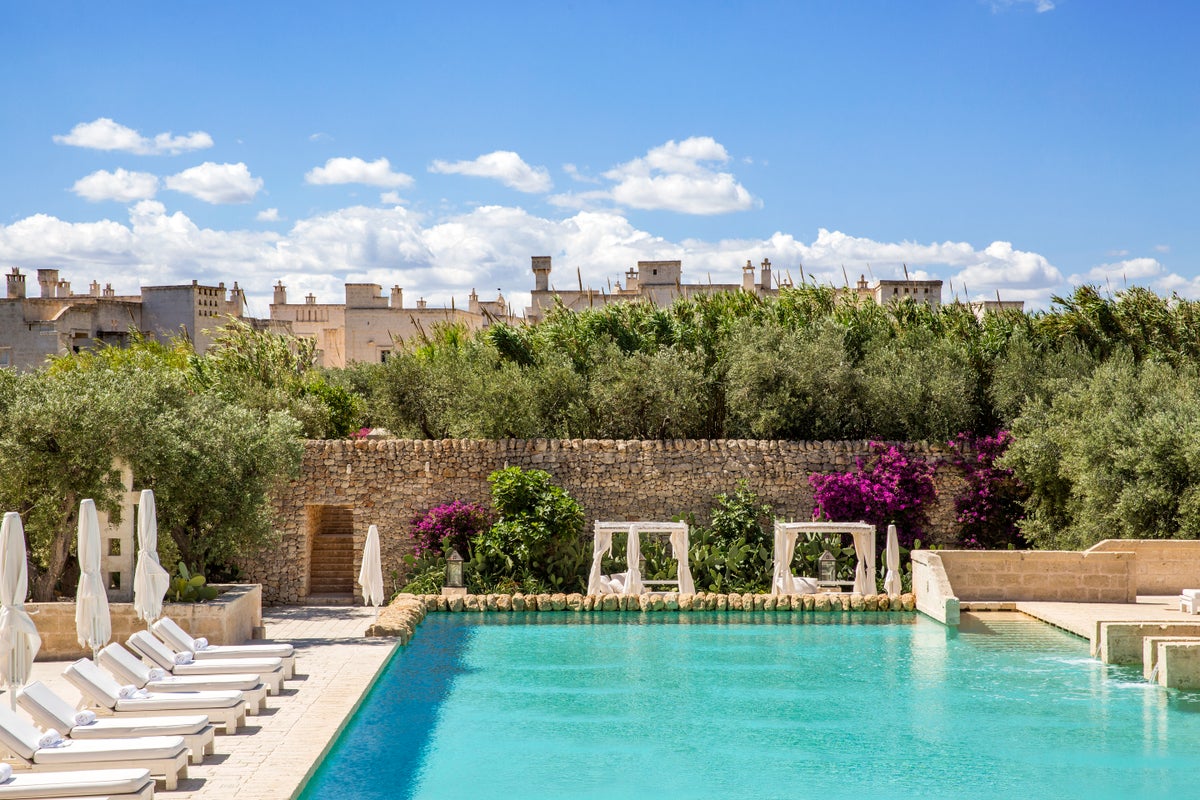
We cycle back to the hotel in a neat line, spokes whirring, weaving through a patchwork of silver-green olive groves. In flat fields uninterrupted by high-rises or clunky machinery, the odd worker toils by hand in the evening sun, maintaining the grids of knarled, ancient trees, some with trunks as thick as oil drums.
Skimming into the ivory-stone courtyard, we hand our bikes to a waiting attendant and slink off to the pool, bagging loungers next to none other than Downton Abbey’s Hugh Bonneville. My partner and I lazily raise our heads from our loungers as we spot him, but it’s no big shock. Of course Hugh’s here. He was across from us at the beach club yesterday.
Olive groves, cycling jaunts, beach clubs, celebs – this is Puglia, sometimes known as Apulia, the swathe of farmland and craggy coast that makes up the “heel” of Italy’s boot-shaped land mass. Recommendations for this chunk of Italy have simmered and swirled for years now among the most clued-up travellers, but the region has really come into its own in the past three years; magazine covers featured its unspoiled green pastures and distinctive, conical trulli houses.

Travel publications named it the “it” destination for the jet set. Moneyed Brits booked destination weddings and honeymoons. Before I fly off to it, one travel industry figure warns me, sombrely, against visiting in still-peak September. “There are more Americans there than ever before,” they say, ominously, insinuating that this is what signifies the death knell for a cool destination.
Perhaps we got lucky, but Hugh was the only trace of global starriness we found in mid-September Puglia. What hit me more was the spellbound sleepiness of the place: cycling between its masserias (charming old farmhouses given new life by hoteliers and restaurateurs), you could hear actual birdsong. Far from pumping chillout tunes, its beach clubs were largely shut up, lapped by frisky autumn waves.
The lilt of life here is seductively easy to slip into: you spend parts of your days relaxing at character-packed, rustic-chic hotels with lovely pools, and are seemingly only ever half an hour’s cycle away from a gorgeous whitewashed village or an Instagram-worthy swimming cove.
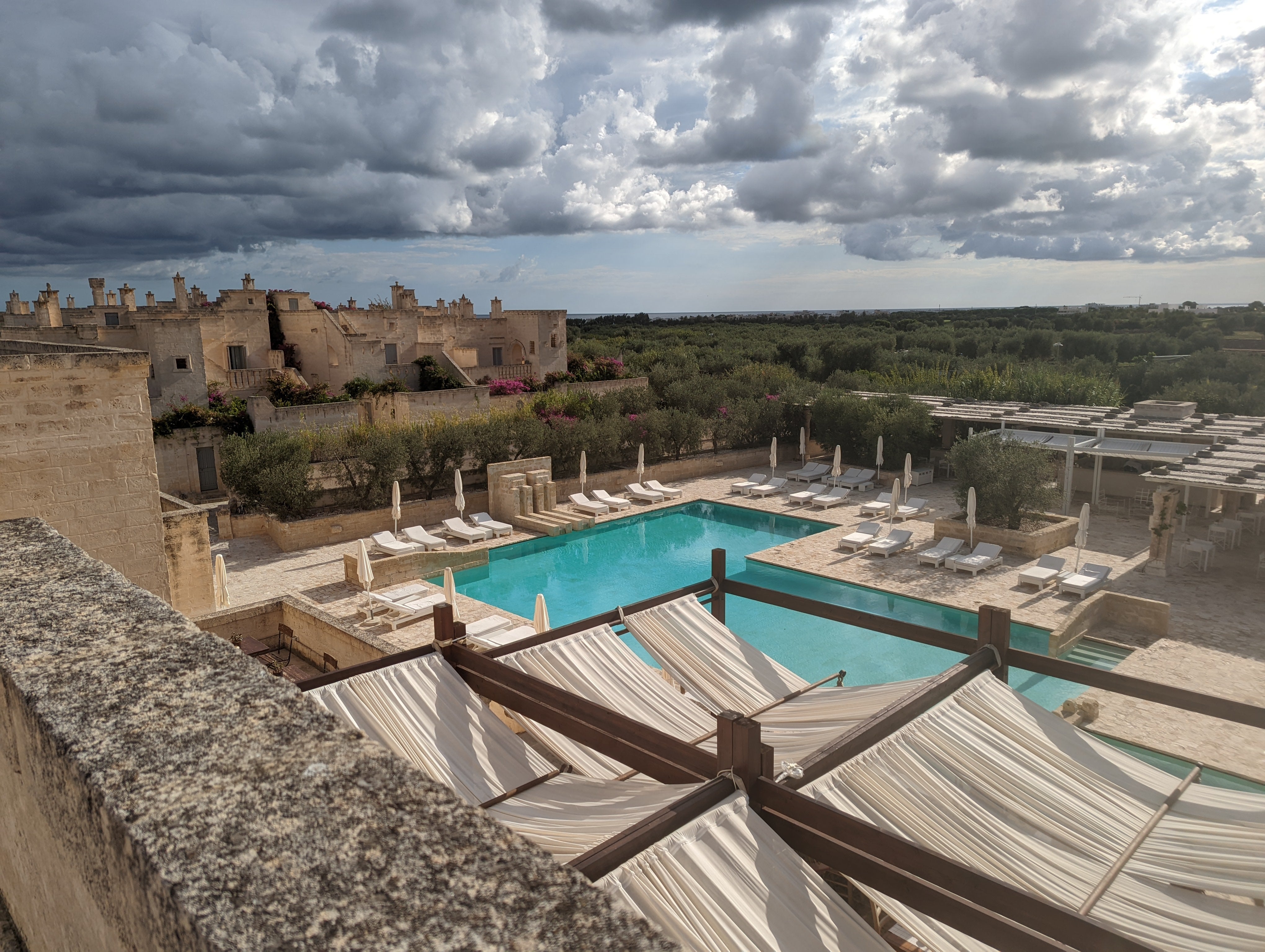
Our first stop, the heavenly Borgo Egnazia hotel, neatly epitomises the architecture, food and style of the region. As well as a sun-soaked, double-tiered pool surrounded by olives, bougainvillaea and prickly pear plants, there’s region-obsessed cuisine and even a fabulous little boutique championing the ceramics, fabrics and produce of the area. Laid out like a mini-village rendered in ivory-gold stone, it comes complete with its own “town square”, hosting festas and pizza nights under the stars.
Nevertheless, a row of immaculate bicycles encourages us to get out and about. With a small group, we pedal to a nearby olive oil farm, in an oil-painting-ready villa dating back to 1754. Here, as a chubby dog lazes in the sun nearby, curly-haired Alessandro Colucci walks us through the history of the oil’s production, a real masterclass in this lifeblood of Puglia. We learn about the many ways an olive oil can pass or fail the extra virgin test, tasting Mr Colucci’s wares to check for the correct levels of grassiness, acidity and peppery spice.
We taste plenty more of the green nectar over a series of satisfying lunches and dinners over the week. At Casa Masciola, I wind tendrils of spaghetti around juicy, shell-plucked clams in a haze of joy alle vongole, each bite set off by the bright sharpness of local Verdeca white wine. In a moonlit square in pretty Polignano a Mare, octopus tentacles have been rubbed with it before a good roasting on a flickering charcoal grill. At Palazzo Guglielmo, in the far southern Salento sub-region, it flavours the whole flame-roasted sea bass we flake off the bone, and caramelises the garden veg that accompanies it. We dunk so much thick, rustic bread into the stuff that we end up cutting ourselves off from this ritual, increasingly unable to get to the dessert finish line.
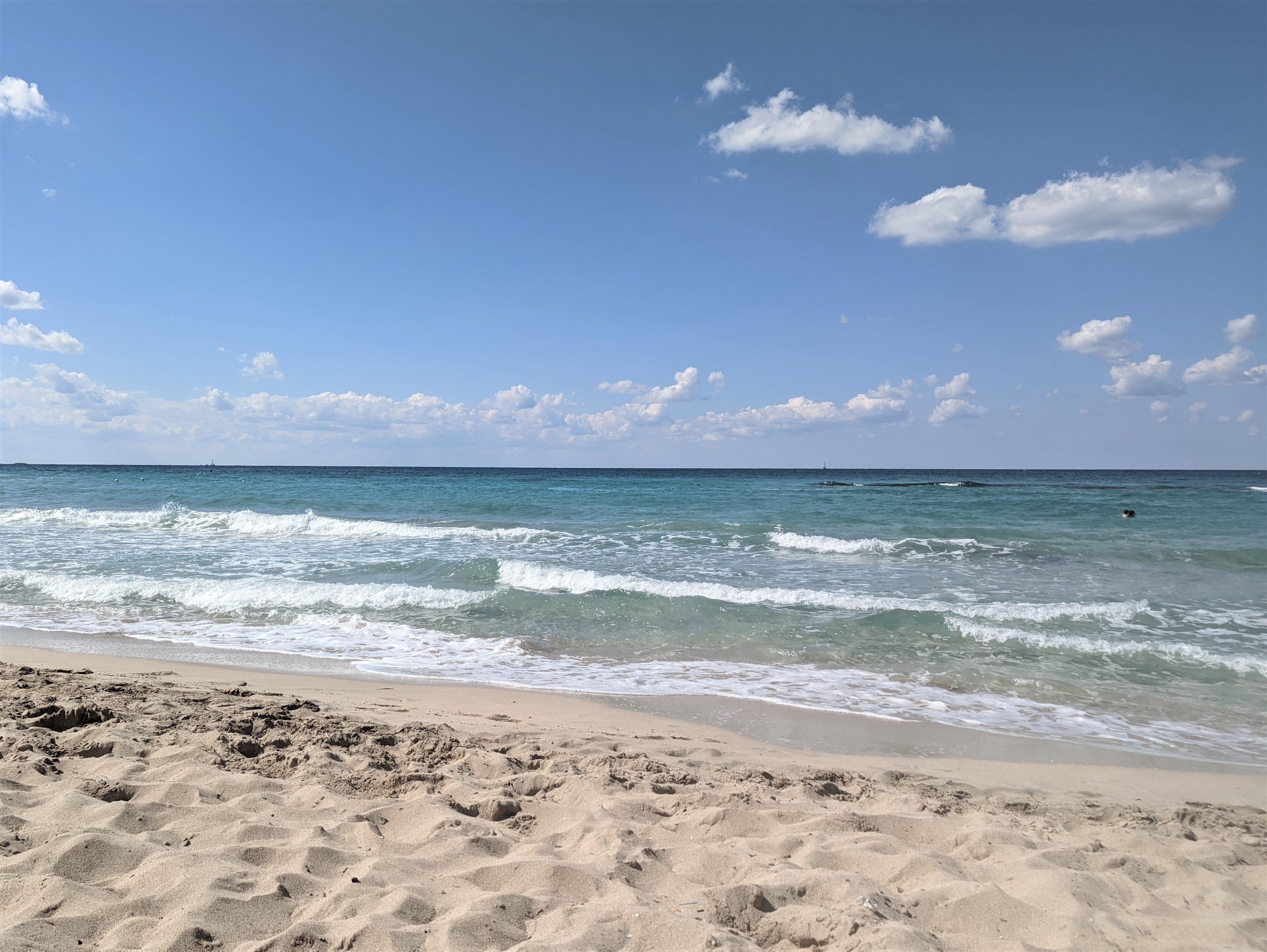
In between these feasts are idyllic beach afternoons. Seaside moments are plentiful here, thanks to lovely coast on all sides; we quickly find that the sandier beaches tend to be on the Ionian coast, the rockier, jewel-bright coves on the Adriatic side. We aren’t sure we’re at the right place when we skim into a deserted car park close to Padula Bianca, one of a string of beautiful beaches we’ve been recommended along a scoop of coast between Porto Cesareo and Gallipoli. Weaving between seemingly closed-up holiday apartments and the odd van, we get closer to the sound of waves, emerging onto heavenly pine-backed white sands.
In early autumn the waves are warm and inviting, and we plunge in giddily, delighting in the clarity of the water and the quietness of the beach. After days of fine dining, there’s something incredibly decadent about a prosciutto panini and a freshly de-capped Peroni, barefoot on the sand. It’s the least luxury we’ve encountered so far, and somehow the most delicious moment with the best view.
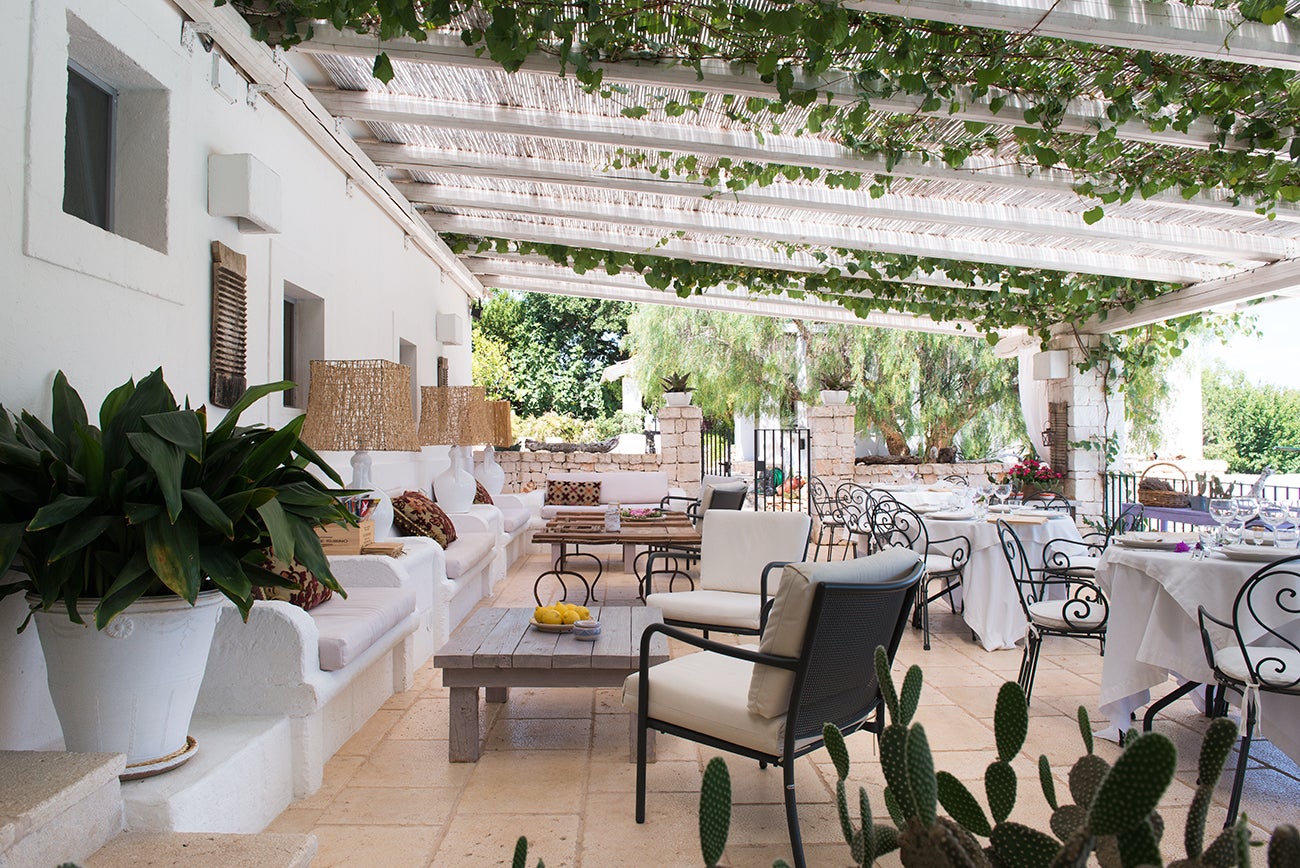
Your only problem in Puglia, were you to go looking for one, is too much choice. On a Google map, I had collated breathless ‘Oh, you must…’ tips from friends and acquaintances, ending up with a dizzying cluster of pins, some of them hours’ drive from our hotels. With only a week to play with, we decisively earmarked half a dozen towns we’d like to visit, along with a handful of beaches and one or two restaurants outside of the masserias.
We opt to stay first near Bari, our flying-in point, then midway down the heel, near Ostuni, finishing up in quirky and charismatic Castro, at the very tip, with an hour to 90 minutes’ direct drive between each. If you had two weeks, you could go much slower, mixing lazy days of spa treatments and wine tastings with more intrepid cycles, hikes and city visits.
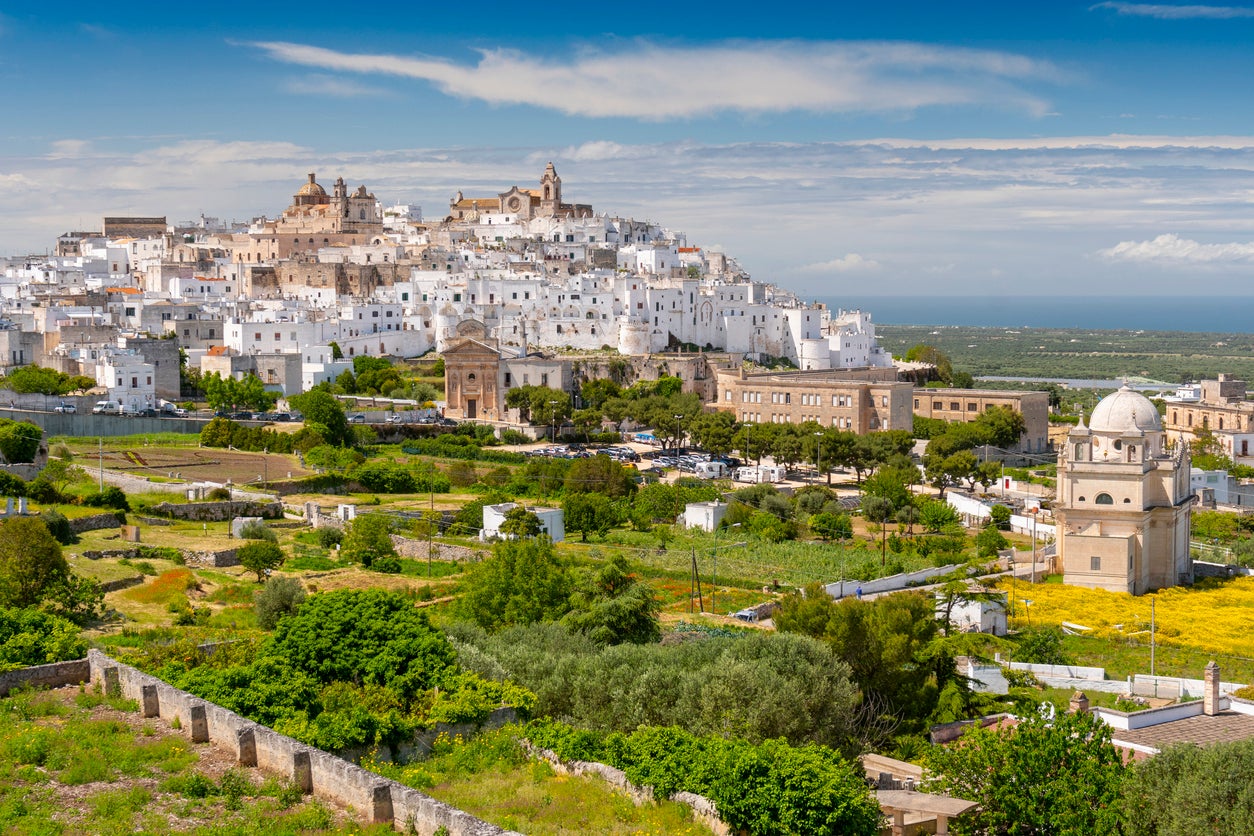
My own breathless, don’t-miss-it highlight is Ostuni. A Greek-influenced hill town swirling up from the green Valle d’Itria, the “White City” is best visited for a golden-hour wander before a satisfying dinner in one of its twinkly, romantic trattorias. We sip Aperol Spritzes in a sunny piazza before taking to its cobbled, concentric lanes, admiring the imposing church of St Vito the Martyr and browsing soft scarves and limoncello in pretty tourist boutiques. This is probably the busiest we’ve found Puglia, but it’s a gentle, happy fizz of holidaymakers (even the Americans don’t spoil the vibe).
The city of Lecce – also known as “the Florence of the south” – makes for another golden, blue-skied afternoon. With a glut of gorgeous, unspoiled churches, ornate convents and domed theatres, it’s catnip for photography and history buffs alike. With none of the hit list of Rome or Venice, this is a place to simply wander – popping into fresco-laden churches and stopping off for gelato or aperitivi. There are enough pretty alleyway cafes to skip the reservations and just follow your nose.
What we don’t find here in autumn – which perhaps explains the lack of crowds – is reliably roasting Mediterranean sunshine. Instead, mostly-bright days in the low-20s Celsius waft into chilly breezes and spells of lingering cloud. This is the season to explore, not marinate in sunscreen: whether that’s seeking out pretty villages, wineries, swimming spots or cycling routes. And we’re happy to do it.
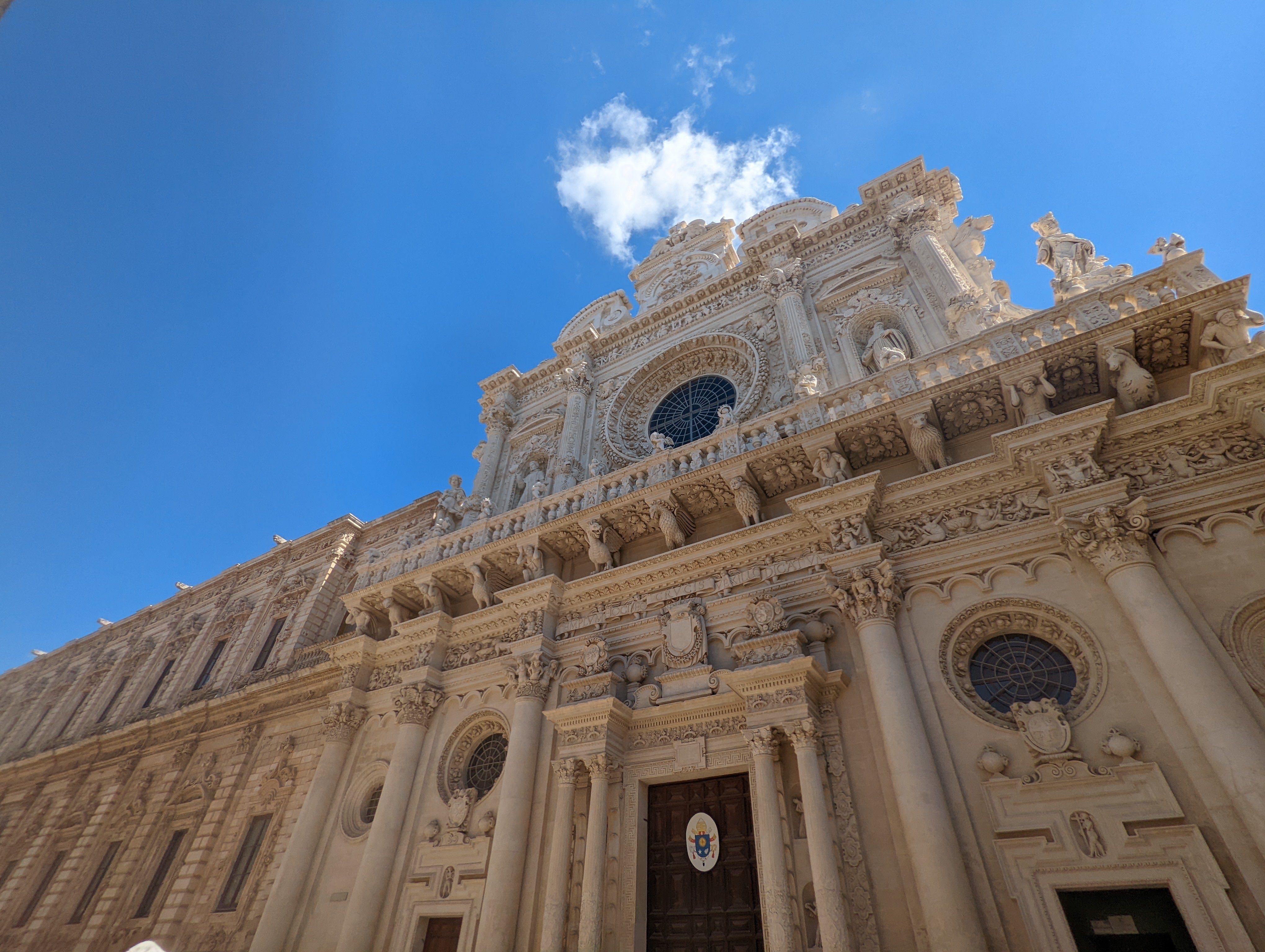
We spend our final afternoon strolling the seaside town of Castro, with its French Riviera looks, stumbling across a world-class sushi restaurant with a sparkling sea backdrop. We digest and swim at Cala dell’Acquaviva, just along the waterfront – a pale-jade suntrap of a cove cut deep into the rock. Though blue that I’ve run out of days to explore the area, I sit back and marvel at how much we’ve seen and done – with very little crowd control along the way.
Travel essentials
Getting there
Trying to fly less?
You can get to southern Italy from the UK entirely by train. After taking the Eurostar from London to Paris, catch a TGV service to Turin in northern Italy, and a local Italian train on to Bari to start your Puglia trip.
Fine with flying?
Alternatively, British Airways has flights to both Bari and Brindisi in the region from £46 each way – compare prices to get the best deal, or consider flying into one and out of the other.

Staying there
Borgo Egnazia is one of the many glamorous options in Puglia, and one of the most established hotels of the region. It truly delivers a dose of what makes this area great, from architecture to food and crisp, white rooms, plus some fun food and drink innovations (an all-veggie upmarket restaurant, for example, as well as its own house vermouth). Doubles from £285, B&B.
If you want to book a masseria, Sawday’s has dozens of glorious, authentic and family-owned properties on its books. Masseria Salinola has the best location for visiting Ostuni, plus a historic and impressively traditional restaurant. Fire pits are lit around the property by night, prompting warm al fresco nightcaps from the honesty bar. Doubles from £146, B&B.
Palazzo Guglielmo, near Castro, is a grand building set around a citrus-tree-shaded courtyard pool. It hosts fun fish barbecues and other communal feasts to get guess mingling, and hides treats from a basement spa to a rooftop hot tub. You can book a trulli stay through apuliarentals.com. Doubles from £111, B&B.







